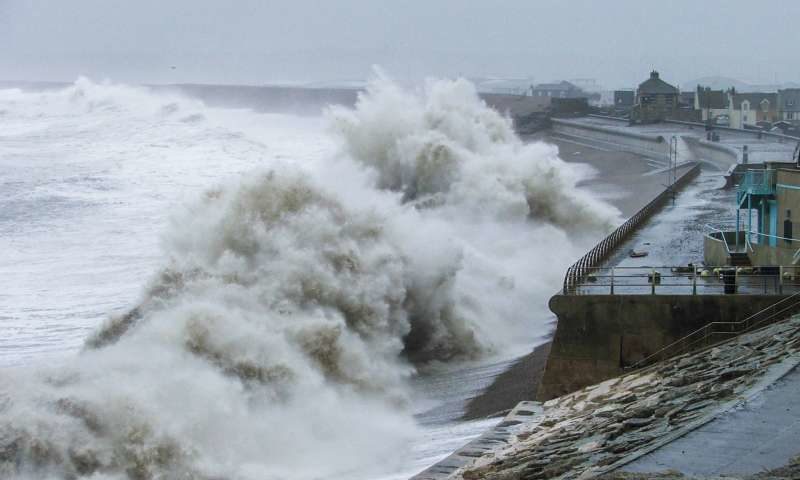
The coastlines of Scotland and Ireland have seen the largest increases, with the average height of winter waves more than 10mm/year (more than 0.7metres in total) higher than in 1948.
That has also led to increased wave heights during extreme weather conditions, with levels off the Irish coast increasing 25mm/year during the past 70 years, representing an average increase of 1.7m.
The study, accepted for publication in Geophysical Research Letters, a journal of the American Geophysical Union, was conducted by scientists at the National Centre for Scientific Research (CNRS) in France, the University of Bordeaux and the University of Plymouth.
They say its findings are important for scientists and coastal managers looking to predict future wave heights, and take measures to protect coastal communities across Western Europe.
Dr Bruno Castelle, Senior Scientist at CNRS, said: "The height of waves during winter storms is the primary factor affecting dune and cliff erosion, explaining up to 80% of the shoreline variability along exposed sandy coasts. So any increases in wave heights, and greater frequency of extreme storms, are going to have a major impact on thousands of communities along the Atlantic coastlines of Western Europe. This work and our other recent studies have shown both are on the rise, meaning there is a real need to ensure the Atlantic coasts of Europe are protected against present and future storm threats."
Comment: Coastlines all over the world are showing significant signs of change:
- White Cliffs of Dover Suffer Large Collapse
- Iconic natural rock arch collapses onto beach in Morocco
- Tidal surge erodes coastline by 1 metre over the weekend in Skipsea, Yorkshire
The study used a combination of weather and wave hindcasts, and actual data, to measure changes in wave height and variability on coastlines from Scotland in the north to Portugal in the south.
These were then correlated against two climate indices - the North Atlantic Oscillation (NAO), which has long been known to affect climate variability in the Northern Hemisphere, and the West Europe Pressure Anomaly (WEPA), based on atmospheric pressure along the Atlantic coast of Europe.
Comment: That doesn't bode well for the future because scientists are now reporting that the NAO is at its weakest in over 1000 years.
The results showed that all areas had seen an average rise in winter wave heights during this period, although it varied from 10mm/year in Scotland, to 5mm/year in France and 1mm/year in Portugal.
The same scientists have previously shown that the winter storms of 2013/14 were the most energetic to hit the Atlantic coast of western Europe since records began in 1948.
Professor Gerd Masselink, Lead of the Coastal Processes Research Group at the University of Plymouth, said: "Whether extreme winters such as that of 2013/2014 will repeat more frequently and/or further intensify in the future is a key issue for the Atlantic coast of western Europe. It is therefore important to investigate if these extreme winters are already happening with increasing regularity and intensity, and why this is happening. If human-induced climate change is responsible, we need to seriously start thinking about decreasing our vulnerability to extreme storm events and pro-actively adapt to a more energetic future wave climate.
Explore further: The West Europe Pressure Anomaly could lead to enhanced forecasting of extreme wave conditions
More information: Bruno Castelle et al, Increased winter-mean wave height, variability and periodicity in the North-East Atlantic over 1949-2017, Geophysical Research Letters (2018). DOI: 10.1002/2017GL076884
Journal reference: Geophysical Research Letters
Provided by: University of Plymouth
Read more at: https://phys.org/news/2018-04-winter-heights-extreme-storms-western.html#jCp



Comment: And it's not just the coastlines that are being affected:
- 'Sinking' Pacific Island is actually growing
- Three cliff falls in just two days near iconic Seven Sisters, UK; woman killed
- Sinkhole appears on beach in French Riviera (PHOTOS)
- Sandy beach that 'vanished' 12 years ago in freak storm suddenly returns overnight in Mayo, Ireland
- Devon residents alarmed as beach disappears overnight
- More cracks reported in Kenya as Africa's geographical divide deepens
- Monster cracks appear in the ground after landslide and heavy rains destroy over 100 buildings in Cusco, Peru (PHOTOS, VIDEO)
- GARGANTUAN sinkhole swallows several cars and building is evacuated in Rome (VIDEO)
- 8 dead as massive sinkhole swallows eight-lane road in Foshan, China (PHOTOS, VIDEO)
Also check out SOTT radio's: Behind the Headlines: Earth changes in an electric universe: Is climate change really man-made?